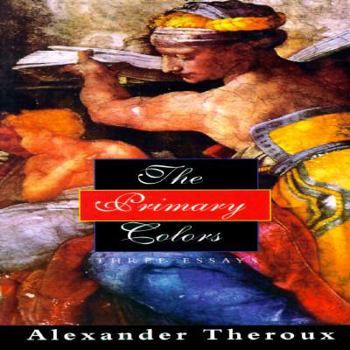The Primary Colors: Three Essays
Select Format
Select Condition 
Book Overview
A fascinating cultural history, these splendid essays on the three primary colors--blue, yellow, and red--extend to the artistic, literary, linguistic, botanical, cinematic, aesthetic, religious,... This description may be from another edition of this product.
Format:Paperback
Language:English
ISBN:0805047018
ISBN13:9780805047011
Release Date:January 1996
Publisher:Henry Holt & Company
Length:288 Pages
Weight:0.55 lbs.
Dimensions:0.8" x 4.3" x 7.4"
Customer Reviews
3 ratings
"Is motion the only reality?"
Published by Thriftbooks.com User , 15 years ago
He's one of my favorite writers (recently I reviewed "Laura Warholic," his latest novel and "Three Wogs," his earliest fiction) but he's certainly sui generis. I have no idea how, especially pre-Internet and pre-search engines, he compiled the thousands of allusions, citations, song lyrics, art works, and trivia that accumulate here to explore blue, yellow, and red. His prose style here, unlike his fiction, may be either more accessible or less cohesive for his readers, but if they've enjoyed his novels, they'll welcome these brief, but densely packed, essays. He raises, of course, many more questions than even he answers. And he knows a lot, such that you'll feel inept by comparison; a common reaction perhaps to encountering his formidably erudite prose. Still, if you want a counterblast to the usual piddle that passes for thought, he'll prove rewarding. As with all his books, it's not to be dashed through, but better savored for its style and contemplated for its observations. Here's a few that struck me. Blue and green often mix in most languages; Theroux wonders if this may be due to a very recent development of our retinal cones that perceive blue. I'm curious if recent genetics can solve this crux. Also, colors enter languages in the same order: first black and white,then red, and then either green or yellow followed by the other. The fifth color separates the third and fourth, resulting in blue. There's no footnotes or sources given, for if there were it'd be equal to the text itself easily. But, I wish I could find out from where Theroux piled up such arcana. On pp. 102-03, for example, he goes in one paragraph from yellow eyes in Frankenstein to a Dickens character, Leon Trotsky about Stalin, Arab boys, a film based on Balzac, Catherine Deneuve's sister, a woman in Walker Percy's "The Moviegoer," another in a García Márquez tale, Sam Spade, and ends with "the Alaskan Gray Wolf, staring directly at you." The yellow chapter, compared to the red and blue, appears more bilious and more disturbing, and Theroux seems to share in that color's enigma. (One minor correction on pg. 120: Christo's artistic display of yellow umbrellas "on a landscape in California" appeared not in 1984 but in October, 1991. Blue ones in Japan were unveiled concurrently.) Still, my favorite sentence is here: "And is there not a flow in the streaming tresses of willow trees, in the sweep of their thin xiphoidal leaves blowing in the wind, as delicate as Veronica Lake's aureoline hair?" (138-39) Although the blue section appears to solve any question and hundreds more I may have had about that color, I still did not find a direct reference to why the music's so called, except for an implication that depression matches this shade. I had thought there was a connection between the indigo-picking slaves and their hands, stained with the plant, as they played and sang sad music. But, that's not found, and neither is, except again indirectly through Eva Péron, any
THEROUX IS TOPS !
Published by Thriftbooks.com User , 19 years ago
Gifted author, wordsmith, scribe, literary craftsman, all of these describe Massachusetts writer Alexander Theroux. And he proves it in The Primary Colors. Sometimes eccentric, always entertaining, each of these essays reads like one man's imaginative, magical dialogue. To Theroux, "Blue is a mysterious color, hue of illness and nobility; the rarest color in nature." It is, of course, also Windex, Blue Willow china, bluegrass, and even baseball player Vida Blue. And, it is the favorite color of the Amish with their blue gates. In the author's gifted hands the color does not limit his discourse, but is a springboard for a trip around the world. Rather than suggesting age, cowardice or decay, yellow to Theroux is a positive hue - a reminder of the sun, spring, and much of autumn's beauty. This sunny shade is light, perfume and the color of the Cadillac driven by /Sammy Glick in "What Makes Sammy Run." Calling red the boldest of colors, Theroux writes, "It stands for charity and martyrdom, hell, love, youth, fervor, boasting, sin, and atonement." From Tabasco sauce to rubies to London buses and fezzes, the author's observations regarding crimson are both witty and surprising. He exaggerates, he's rambunctious; Theroux references everything - art, history, music, psychology, movies, gossip, sociology, and television. All of which make fascinating reading. - Gail Cooke
art to poetry
Published by Thriftbooks.com User , 23 years ago
These essays are a glorious excursion into the depth of color. Each becomes an adventure story combined with poetry. The history and sociology that Mr. Theroux brings into the world of simple RED, BLUE, and YELLOW uplifts and excites. Each paragraph makes you want more and more.





